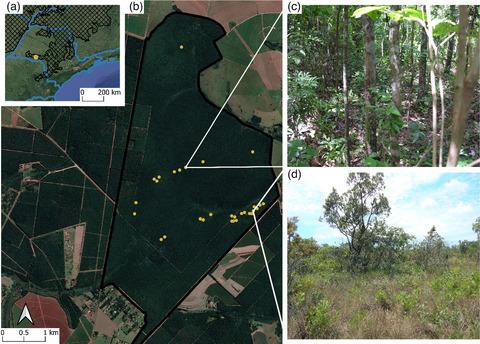Our official English website, www.x-mol.net, welcomes your
feedback! (Note: you will need to create a separate account there.)
Not all trees can make a forest: Tree species composition and competition control forest encroachment in a tropical savanna
Journal of Ecology ( IF 5.3 ) Pub Date : 2021-12-03 , DOI: 10.1111/1365-2745.13820 S.W. Flake 1 , E.A. Honda 2 , N.A.L Pilon 2, 3 , W.A. Hoffmann 1 , G. Durigan 2, 3
中文翻译:

并非所有树木都能造林:热带稀树草原的树种组成和竞争控制森林侵占
更新日期:2021-12-03
Journal of Ecology ( IF 5.3 ) Pub Date : 2021-12-03 , DOI: 10.1111/1365-2745.13820 S.W. Flake 1 , E.A. Honda 2 , N.A.L Pilon 2, 3 , W.A. Hoffmann 1 , G. Durigan 2, 3
Affiliation

|
- Forest encroachment into savannas is a widespread phenomenon, the rate of which may depend on soil conditions, species composition or changes in stand structure. As savanna specialist trees are replaced by generalist species, rates of stand development may increase. Because generalists can persist in forests, they are likely to grow more quickly and survive longer in dense stands, compared to savanna specialists. Furthermore, the faster growth rates of generalists may allow them to overtop and outcompete savanna specialists, causing rapid species turnover.
- We measured growth and survival of 6,147 individuals of 112 species of savanna and generalist tree species over a period of 10 years in an ecological reserve in Assis, São Paulo State, Brazil. We modelled growth and mortality as a function of soil texture and nutrients, tree size, competitive neighbourhood, and membership in savanna or generalist (species which can persist in forests and savannas) functional groups.
- Tree growth and survival was strongly influenced by competition, as estimated by the basal area of trees taller than a focal tree. At the stand level, savanna species are unable to contribute basal area growth in closed stands, while generalist species continue to increase in basal area even at high stand basal area. This phenomenon is driven by differences in growth and mortality. Generalists grew faster than savanna species, both in height and diameter. This difference in growth rates led to savanna species becoming suppressed more rapidly than generalists. When suppressed, savanna species were more than twice as likely to die than were generalists. Soils had inconsistent and mostly weak effects which were difficult to separate from gradients of stand structure.
- Synthesis. We demonstrate that the presence of generalist trees accelerates the rates of basal area accumulation due to their greater growth rates and tolerance of shading. Generalists outcompete savanna trees by growing faster in the open and overtopping savanna specialists. Due to the slow growth and high mortality of savanna species in the shade, they are unable to form closed-canopy stands. Accounting for differences among functional types and development of vegetation structure is critical for modelling forest encroachment.
中文翻译:

并非所有树木都能造林:热带稀树草原的树种组成和竞争控制森林侵占
- 森林侵占稀树草原是一种普遍现象,其速度可能取决于土壤条件、物种组成或林分结构的变化。随着稀树草原专业树被通才物种取代,林分发展率可能会增加。因为通才可以在森林中生存,与稀树草原专家相比,它们可能会在茂密的林分中生长得更快并存活更长时间。此外,通才的较快增长速度可能使他们超越并超越稀树草原专家,从而导致物种快速更新。
- 我们测量了巴西圣保罗州阿西斯生态保护区 10 年内 112 种稀树草原和通用树种的 6,147 个个体的生长和存活情况。我们将生长和死亡率建模为土壤质地和养分、树木大小、竞争社区以及稀树草原或通才(可以在森林和稀树草原中持续存在的物种)功能组的成员。
- 树木的生长和生存受到竞争的强烈影响,这是根据比焦点树高的树木的基面积来估计的。在林分水平上,稀树草原物种无法在封闭林分中贡献基面积增长,而通用物种即使在高林分基面积也继续在基面积增加。这种现象是由生长和死亡率的差异驱动的。多面手在高度和直径上都比稀树草原物种生长得更快。这种生长速度的差异导致稀树草原物种比通才更快地受到抑制。当受到抑制时,稀树草原物种死亡的可能性是通才的两倍多。土壤具有不一致且大多是微弱的影响,难以从林分结构的梯度中分离出来。
- 合成。我们证明,通才树的存在加速了基底面积积累的速度,因为它们具有更高的生长速度和对阴影的耐受性。通才通过在开阔和超越稀树草原专家中更快地生长来胜过稀树草原树。由于稀树草原物种在阴凉处生长缓慢且死亡率高,它们无法形成封闭的树冠林分。考虑功能类型之间的差异和植被结构的发展对于模拟森林侵占至关重要。











































 京公网安备 11010802027423号
京公网安备 11010802027423号